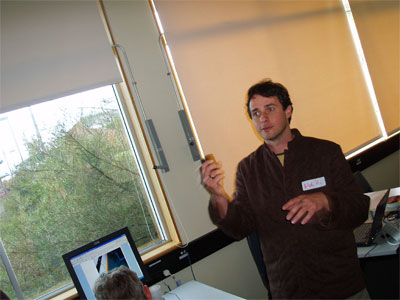Marks in constant recording
 Recently a few friends came up to the mountains for the TALO swap/meet 05. We talked about a variety of things to do with teaching and learning online. The nature of the conference was open source - meaning that there was no agenda, key note speakers, or otherwise structured communications. We just got together and started yaking! It was great. Some really good ideas and thoughts were flowing freely. We talked over a Mexican lunch, we talked while walking the National Pass Trail, we talked over drinks at the Carrington, we talked and talked.
Recently a few friends came up to the mountains for the TALO swap/meet 05. We talked about a variety of things to do with teaching and learning online. The nature of the conference was open source - meaning that there was no agenda, key note speakers, or otherwise structured communications. We just got together and started yaking! It was great. Some really good ideas and thoughts were flowing freely. We talked over a Mexican lunch, we talked while walking the National Pass Trail, we talked over drinks at the Carrington, we talked and talked. Recording such conversation is almost impossible. Remembering all the great ideas is just as impossible. But I remember one idea Alex Hayes (pictured), Sean FitzGerald and I had that could solve this problem - the marking in constant record.
Take your average mp3 recorder. Mic yourself up and hit record. On a 512meg card you should expect a few hours of recording, enough to get the majority of a night conversation. But going back over that massive flog of raw recording to edit it down to digestible content is a job I wouldn't wish on anyone. On top of that, once the 512 card is full, you have to find another card to get the breakfast conversations. Its just too much. What we really need is a recorder that does constantly record, but when you have that moment in conversation where you realise, "hey, that's a great idea!" you reach down to the mic cable and press a button that marks near to the end of the sample you want to keep. The recorder stores your out point mark and adds an inpoint mark automatically - say 5 minutes before the out. When the cards nears full, the recorder deletes everything but the marked recordings, freeing up some card to continue recording. Back in the editing misery, at least you know that the majority of what you have is what you though was good at the time. You might miss a few things with that auto 5 minute in point mark, but I'd say on the whole you'd get most of it. 5 minutes should be enough I'd imagine, for someone recording to realise what was being said was worth keeping. If that person was to mark an out point within 5 minutes of the last, then the reorder would know that more than 5 minutes was needed, it would just keep the in point at the original mark point.
This could work for video as well of course.

This work is licensed under a Creative Commons Attribution 2.5 License.


